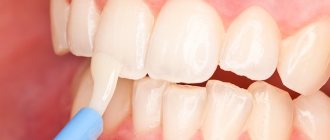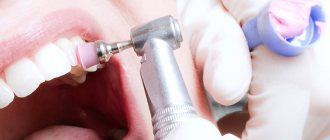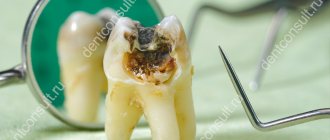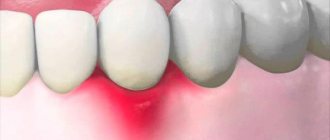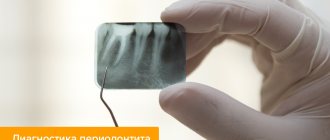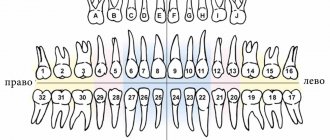Author of the article:
Soldatova Lyudmila Nikolaevna
Candidate of Medical Sciences, Professor of the Department of Clinical Dentistry of the St. Petersburg Medical and Social Institute, Chief Physician of the Alfa-Dent Dental Clinic, St. Petersburg
Drinking coffee and tea, smoking are the reasons for the formation of areas of enamel staining. The love of sweets, juices, fruits, combined with improper oral care, also leads to the fact that the enamel suffers: areas of demineralization, sensitivity, and caries appear. How to get rid of such unpleasant phenomena as dark pigment on teeth and sensitive enamel?
For this purpose, many different preparations are produced in the form of special toothpastes, gels, and varnishes. Let's talk about dental varnishes and alternative products. Some solve cosmetic problems and are intended for home use, others are used for therapeutic purposes and are applied by a doctor.
Types of dental varnishes for teeth
Whitening cosmetic varnishes
Professional whitening, which is offered by dental clinics, has one drawback - high cost. But there are options on how to achieve the effect of a “Hollywood” smile at minimal cost. Teeth enamel whitening varnish will help with this.
It makes teeth white from the first application, brightening them by at least 10 shades and giving a glossy shine. Products from different manufacturers may differ in the degree of whiteness and duration of action, but on average, one coat of teeth with varnish is enough for a maximum of a day. The principle of action is similar to nail polishes: the teeth are temporarily stained and, as a result, become whiter.
After the composition dries, a white film coating forms on the teeth, which can be easily removed with a toothbrush if desired, but can also be easily removed along with solid foods and drinks. The effect of whitening varnish-paint does not affect your own enamel; it will not relieve tooth sensitivity, if any.
The coating can be applied to restorations: on fillings, veneers, and crowns, it will have the same properties as on regular teeth.
The composition of different teeth whitening varnishes may vary, but some components are present in all products:
- film former;
- coloring component.
With repeated use, such varnishes can lighten your own tooth enamel by several tones. Manufacturers assure that, in addition to coloring, such varnishes have a remineralizing effect due to a special additive (hydroxyapatite), that is, they help restore and strengthen tooth enamel. In addition, the film has antiseptic and bactericidal properties, thus, while present on the teeth, it protects them from cervical caries.
Main indications for the use of whitening varnish:
- pigment spots on enamel;
- darkening of enamel from tobacco, coloring foods and drinks;
- difference in color of fillings and crowns.
Teeth whitening varnishes are good as a temporary solution, for example, for photo shoots, special events or public appearances when you need to look perfect. Safety: whitening varnishes do not contain acetone and other chemically hazardous components, therefore they do not damage tooth enamel and mucous membranes, and do not cause discomfort during application and presence in the mouth.
Note that whitening varnishes are not effective for problems such as moderate and severe forms of fluorosis, enamel hypoplasia, severe chips: in this case, tooth defects cannot be masked with several layers of varnish. With such defects, only ceramic restoration can improve the aesthetics.
Fluoride varnishes
Fluoridation is a procedure that is performed in a dental office. Goes in combination with professional oral hygiene.
When areas of enamel demineralization appear on a tooth, it becomes sensitive: it reacts to cold, hot, acidic foods and drinks. Dentists use fluoride preparations that seal open dentinal tubules, eliminating increased sensitivity.
Problems that fluoride varnish solves:
- decreased enamel sensitivity;
- prevention of caries;
- preventing further development of caries when it is at the spot stage.
Unlike whitening varnishes, fluoride varnishes are absolutely transparent on the teeth and do not have a whitening effect, but due to the preliminary removal of soft and hard plaque from the teeth during professional hygiene, the enamel is slightly lightened. Fluoride varnish creates a colorless protective film on the tooth surface that prevents the harmful effects of bacteria.
Fluoride-containing preparations are not applied to crowns, veneers, or dentures. It is recommended to begin fluoridation procedures in childhood, from the moment the baby teeth erupt, as this will protect the rudiments of permanent teeth. Fluoridation is also carried out for pregnant women, since the drugs are safe and do not have a negative impact on the health of a woman expecting the birth of a child. Fluoridation is especially recommended after removal of braces and clinical whitening.
The composition of fluoride varnish includes:
- sodium fluoride;
- chloroform;
- shellac;
- ethanol;
- fir resin.
Many have heard about the dangers of fluoride, and we have already talked about the consequences of its excess in the body. Dentists agree that the use of toothpastes with fluoride at a certain concentration of this element has a bad effect on tooth enamel and on health in general, especially if there is an increased content of fluoride in drinking water in a given region. But the concentration of fluorides in fluoride varnish is very small and cannot harm dental health. Therefore, fluoridation is recommended for the population even in regions with high fluoride content in water.
Remineralizing varnishes for children
Children's dental varnishes for remineralization can be distinguished into a separate category. Varnishes for children's teeth are available in various flavors, so that the little patient has a pleasant impression of visiting the doctor, and he does not feel afraid of the necessary medical procedures. The products contain xelitol, which allows you to fight pathogenic bacteria in the oral cavity some time after application.
Fluoride-containing drugs: myths and reality
L. A. Lobovkina
Ph.D., doctor of the highest category, head of the treatment and prophylactic department of Branch No. 6 of the Federal State Institution “GVKG im. Burdenko" of the Ministry of Defense of the Russian Federation
L. V. Rainauli
Candidate of Medical Sciences, Head of the Dental Department of Branch No. 6 of the Federal State Institution “GVKG im. Burdenko" of the Ministry of Defense of the Russian Federation
A. M. Romanov
chief physician of the Implamed clinic (Moscow)
Currently, Russia occupies one of the last places in carrying out measures to prevent dental diseases. This is explained by the fact that in most cases, doctors have only fragmentary information about the range of means and methods of prevention, as well as a lack of experience and a comprehensive individual approach to carrying out preventive measures [3].
At the same time, global experience in the development and implementation of preventive programs in society has shown that individually focused programs are the most effective [5].
One of the most studied substances that prevent the development of caries is fluoride [6]. Is there a real alternative to fluorides?
- Hygiene products containing xylitol contribute to disruption of the energy metabolism of the main cariogenic species Str. Mutans and stimulate salivation. However, data are conflicting and questions remain about dosage, frequency of administration, and optimal routes of administration.
2 . Products containing chlorhexidine have antibacterial activity against most pathogenic microorganisms of the oral cavity. But when using such products, it is possible to change the composition of the normal microflora (dysbiosis), stain the surface of the teeth and tongue, and disrupt the sense of taste.
3. CPP-ACP (“Rekaldent”) - casein-phosphopeptide-amorphous calcium phosphate. Casein phosphopeptide, due to its adhesiveness, is fixed on the surface of the teeth and serves to transport calcium and phosphate ions to the surface layers of the enamel. However, the quantity and quality of available studies do not allow us to conclusively state the advantage of the Recaldent system over fluoride-containing drugs.
4. Oral hygiene products with bioactive microcrystals. They contain hydroxyapatite, zinc, calcium phosphate and other components, which, according to manufacturers, fill enamel microdamages for a long time, unlike fluorides, which have an exclusively superficial effect. However, such statements lack an evidentiary basis, since there is no literature data comparing the effectiveness of these products with fluoride-containing ones (Kuzmina E. M., 2011).
Considering the fact that the preventive effect of these drugs does not have sufficient evidence, they can be prescribed to patients at high risk of developing caries only as measures that complement the action of fluoride (Maslak E. E., 2015).
Rice. 1. Teeth 31, 41, 32, 42 - initial situation. Rice. 2. Teeth 31, 32, 41 and 42: coating with fluoride varnish VOCO “Profluoride Varnish”
Rice. 3. Teeth 31, 32, 41 and 42 - final appearance. Rice. 4. Teeth 3.3 and 3.4 - initial situation.
Rice. 5. Teeth 3.3 and 3.4 – coated with fluoride varnish “Bifluoride 12”. Rice. 6. Inflating with air “Bifluoride 12”. Rice. 7. Teeth 3.3 and 3.4 - final appearance.
It is advisable to note that the main substance for the prevention of a number of dental diseases has been and remains fluoride! It has been established that topical fluoride-containing products are effective for the prevention of caries in both temporary and permanent teeth [4].
In addition, a number of studies indicate that fluoride is also effective for the prevention of tooth root caries, so it should be used in all age groups (Kuzmina E. M., Smirnova T. A., 2001).
At the same time, there is an opinion among doctors that fluoride is harmful. However, Paracelsus also said: “Everything is poison, everything is medicine; both are determined by the dose.” Therefore, preference should be given to exogenous methods of prevention, which are more controlled and safe compared to endogenous ones.
Today, the dental market has a wide range of drugs for fluoridation of hard dental tissues.
To prevent and treat the initial manifestations of caries, fluoride-containing gels and varnishes are used. Gels typically contain low concentrations of fluoride and are recommended for weekly home use for persons over 18 years of age [2].
Unlike gels, fluoride-containing varnishes can remain on the tooth surface for a long time, thus promoting the accumulation of more fluoride in the enamel [1]. This is especially important at a time when demineralization processes predominate. However, when applying conventional fluoride varnishes, calcium fluoride crystals are freely located on the surface and are quickly removed by mechanical abrasion, making the effect short-lived. Therefore, preference should be given to drugs that have a longer effect.
“ VOCO Profluoride Varnish ” is a fluorine-containing varnish based on a special resin (colophonium) with a 5% sodium fluoride content. Fluoride ions, together with calcium ions present in the tubules, promote the precipitation of calcium fluoride, which leads to reliable sealing of the dentinal tubules. Due to this, the varnish is effective for the treatment of hypersensitivity. Along with this, VOCO Profluoride Varnish forms a depot of calcium fluoride on the tooth surface, which protects the tooth from acid attacks, promotes remineralization and the formation of fluorapatite. In addition, xylitol has been added to the varnish, which, while improving taste characteristics, has a proven cariostatic effect. Colonium resin provides good adhesion, also on wet surfaces. Therefore, the drug can be used even if it is impossible to dry the surface of the teeth well! Thus, the use of this drug significantly saves time.
Clinical case No. 1
Patient I., 47 years old, applied to a therapeutic dentistry clinic with complaints of pain from temperature and chemical stimuli in the area of 31, 32, 41 and 42 teeth.
When carrying out objective research methods, recession of class I periodontal tissues according to Miller was discovered in the area of 31, 32, 41 and 42 teeth, as well as wedge-shaped defects of these teeth (Fig. 1: Teeth 31, 41, 32, 42 - initial situation). A diagnosis was made: teeth 31, 32, 41 and 42 - wedge-shaped defects, hypersensitivity.
The surfaces of the teeth were cleaned using a fluoride-free paste and a brush, then coated with fluoride-containing varnish “VOCO Profluoride Varnish” (Fig. 2: Teeth 31, 32, 41 and 42 - coated with fluoride varnish VOCO Profluoride Varnish. Fig. 3: Teeth 31, 32, 41 and 42 - final appearance).
“Bifluoride 12 ( VOCO )” is a unique transparent fluoride varnish, which is a colorless suspension based on natural tree resin with a pleasant fruity smell and taste. The main active components of Bifluoride 12, unlike all existing fluoride varnishes, are 6% sodium fluoride and 6% calcium fluoride. Due to sodium fluoride, the drug begins to act instantly, immediately after its application, and due to calcium fluoride, it has better penetrating ability, having a long-term therapeutic effect: fluoride is released over several months.
The varnish also contains bioinert Teflon particles, which give it strength properties.
The advantage of “Bifluoride 12” is that it forms a waterproof, smooth protective film that helps insulate from thermal and chemical irritants, which prevents dental plaque from fixing on its surface. In addition, the varnish dries quickly, so to obtain long-term adhesion to the enamel, it should be applied in a thin layer. To maintain the anti-caries effect, re-coating must be carried out after 3-6 months. Single-layer application of varnish saves the doctor’s time and minimizes consumption; Bifluoride 12 is on average 66% more economical than its analogues.
In addition, “VOCO Profluoride Varnish” and “Bifluoride 12” are excellent desensitizers that provide pain relief for hypersensitivity for several months.
Clinical case No. 2
Patient Yu., 36 years old, came to the clinic of therapeutic dentistry with complaints of pain in the area of 3.3 and 3.4 teeth that occurred under the influence of temperature and chemical irritants.
When carrying out objective research methods, hypersensitivity of teeth 3.3 and 3.4 was revealed, which arose after eating citrus fruits (Fig. 4: Teeth 3.3 and 3.4 - initial situation). After cleaning teeth 3.3 and 3.4 using a fluoride-free paste and a brush, Bifluoride 12 was applied (Fig. 5: Teeth 3.3 and 3.4 - coating with fluoride varnish Bifluoride 12. Fig. 6: Blowing with air Bifluoride 12. Fig. 7: Teeth 3.3 and 3.4 - final view).
Thus, given the high level of evidence for the use of fluorides in the prevention of dental caries, it is necessary to use them widely in both children and adults (Maslak E. E., 2015). The doctor’s availability of fluoride-containing varnishes (“VOCO Profluoride Varnish” and “Bifluoride 12”), as well as knowledge of the schemes for their use, allows not only to be confident in the proposed method, but also to provide the opportunity to demonstrate the results obtained to the patient, which, undoubtedly, increases the image of the doctor and the attractiveness of professional prevention in general and, therefore, creates the basis for long-term regular communication [3].
How to use
Instructions for applying teeth whitening varnish
- The varnish should not be applied to the damp surface of the teeth, as it will not adhere to the enamel. Before applying the varnish, you need to clean and dry the surface with a napkin or cotton pad.
- Some manufacturers add a retractor to their whitening kit. If available, place it in the mouth.
- Shake the bottle before use.
- The varnish is applied in a thin layer to the surface of the tooth in the direction from the gums to the cutting edge.
- Wait the recommended time for the polish to dry without covering your mouth. If necessary, apply a second coat of varnish until the enamel is completely covered.
Teeth whitening varnish can be treated at least every day.
Algorithm for applying fluoride varnish
- The working field is isolated from the adjacent surfaces of the lips.
- The surface of the teeth is dried with a cotton swab.
- The doctor coats the teeth front and back with fluoride varnish using a special brush or applicator. The number of applications is determined by the dentist.
- The patient needs to sit with his mouth open for 5 minutes to fix the composition.
It is recommended to carry out fluoridation in the dentist's office 2 times a year.
Alternatives to Remineralizing and Whitening Teeth Varnishes
Various gels, foams and toothpastes are actively used in dentistry to remineralize teeth. Moreover, remineralizing gels and pastes can be used at home. For example, ASEPTA PLUS Remineralization toothpaste with hydroxyapatite, plant extracts, papain and thermal mud helps strengthen teeth and gums and reduces sensitivity. This paste should be used as usual: twice a day for 3 minutes.
Gels for remineralization at home are used in courses. The gel is applied with a toothbrush or finger to all surfaces of the teeth, cleaned of plaque, and left for the time specified in the instructions. Such products can be used in conjunction with universal mouth guards. Remineralizing gels are safe if accidentally swallowed. Their use is indicated after professional cleaning procedures.
For whitening, you can choose a special toothpaste. The effect of its use is cumulative and long-lasting, unlike whitening varnishes for home use, but less pronounced. Professional whitening pastes allow you to lighten the enamel by several tones. Particularly noticeable results are achieved in conjunction with professional teeth cleaning. For effective and safe enamel whitening, we recommend ASEPTA Gentle Whitening toothpaste. The fluoride-free paste contains fine abrasive components that clean the enamel of plaque without leaving microcracks. ASEPTA toothpaste prevents the occurrence of caries and sensitivity.
Interesting products for teeth whitening at home - strips, foam, gel stick. Sticky whitening strips absorb and break down dark pigments and plaque from the surface of teeth, resulting in a lighter natural shade of teeth. You will get visible results within 7 days of regular use of the strips, the maximum effect is achieved within 14 days.
Additional oral care in the form of whitening foam is intended for hygiene throughout the day. Recommended use after every meal. Thick foam breaks down soft plaque even in the most difficult to reach areas, without the need for a toothbrush or water. The active components of the product act on the surface of the enamel and penetrate into its deeper layers, discoloring coloring pigments. Additionally, the product helps strengthen tooth enamel and reduce sensitivity. This is the best option for those who wear braces or other orthodontic structures.
A whitening gel pencil can lighten teeth by 2-4 shades within a week of use. The use of individual trays improves the result, since the gel must be kept on the teeth for 5–7 minutes.
HEALTHY “FOOD” FOR TEETH. Fluoridation of teeth.
Bodrenkova Elena
Hygienist at the Ekostom dental clinic
How effective is this technique? Is it safe? How exactly is it carried out?
There are a lot of questions, and they all require answers. The time has come to fill the gaps in knowledge, and at the same time debunk myths and dispel rumors.
Question one: why do you need fluoridation of teeth?
Most dentists will tell you that this is perhaps the only way to protect tooth enamel, prevent tooth decay (apart from good hygiene and proper nutrition, of course), and also reduce tooth sensitivity. Is it so? In what cases is the procedure effective and in what cases is it not? What does fluoridation do?
SO WHAT IS FLUORIDE?
Fluorine is a gas, and in nature it is often found in compounds with other substances: for example, calcium fluoride or sodium fluoride. Fluoride is the fluoride ion. All organic and inorganic compounds containing fluorine are fluorides, which will be discussed in this article. Fluoride is a natural element that is part of the earth's crust. Therefore, it is natural that a small dose of it (considerably less than one part per million) is contained in natural water. Plants absorb these compounds, so small amounts of fluoride are present in all our food and water, and also accumulate in animal tissue and plants.
LET'S REMEMBER A LITTLE HISTORY
The first statements that fluoride was good for teeth, as well as that it should be added to drinking water to prevent dental disease, were made by doctors Gerald Cox and Harold Hodgy. They became the main defenders of the fluoridation theory. Hoxha was responsible for numerous works in support of the water fluoridation program and its implementation by 1957.
So, what happens to the teeth, why strengthen them?
Metabolic processes constantly occur in teeth. Many people have probably heard more than once about such a phenomenon as the acid-base balance, which must be restored every time after eating. This is explained by the fact that after eating, the pH of the oral cavity becomes acidic. To neutralize this condition, the process of “washing out” microelements from tooth enamel into the oral cavity is activated. This process is called demineralization. If it becomes dominant over the processes of remineralization, then defects appear in the enamel, which subsequently open the way for the development of caries. This is a pathological process in which the hard tissues of the teeth are destroyed. The result is increased tooth sensitivity, caries, and periodontal disease.
Fortunately, modern medicine offers many ways to maintain healthy teeth and restore their natural beauty. One such method is remineralization therapy.
So, let's start step by step. As with any procedure, there are indications and contraindications. The procedure for dental fluoridation is a responsible undertaking. It cannot be done according to your “wish”; the need for fluoridation is determined by a specialist.
Fluoridation of teeth is prescribed:
• to strengthen tooth enamel;
• for the prevention of caries (primary, secondary, in the spot stage);
• to eliminate tooth sensitivity;
• to extend the service life of existing fillings;
• after teeth whitening;
• after removing braces or splinting structures;
• with a genetic predisposition to an imbalance of minerals.
Contraindications to fluoridation:
• increased fluoride content in drinking water;
• allergy to fluoride preparations;
• fluorosis (damage to enamel due to consumption of large amounts of fluoride since childhood).
PREPARATION FOR THE PROCEDURE
Before fluoridation of teeth, dentists recommend: undergoing professional oral hygiene; cure caries and other diseases of the oral cavity, fill non-carious defects.
There are two types of dental fluoridation: simple and deep.
And now in more detail about each method.
SIMPLE FLUORIDATION OF TEETH
This effective and painless method is most common in dental practice. According to reviews of the procedure, some patients experience positive results with tooth sensitivity almost instantly.
So, the first method is the use of individual mouthguards or, as the doctors themselves call them, “spoons.” At your first appointment, your doctor will make a wax impression of your teeth or use standard aligners. The recesses are filled with a special fluoride-containing preparation (usually a gel for fluoridation of teeth). The mouth guard is placed on the teeth for 10-15 minutes. The number of procedures is from 1 to 10.
The second method uses not a gel, but a special varnish. It must be applied to the enamel of the teeth with a brush, being careful not to get on the gums and mucous membranes. Number of procedures - 3-4. The peculiarity of simple fluoridation of teeth is that during this procedure, fluoride does not penetrate deeply, but creates a protective film on the surface of the enamel. Such protection usually lasts for six months. Then the procedure is repeated.
DEEP FLUORIDATION OF TEETH
Deep fluoridation of teeth is a more complex procedure, but also more effective. Here enamel-sealing preparations are used. To be more precise, there are two of them. The first preparation contains copper, magnesium and fluorine, and the second contains calcium hydroxide. Both substances are applied alternately to the teeth. If we omit the chemical terms, we can say that when these drugs interact, tiny crystals are formed that fall into the pores of the enamel and seal them. Now your teeth are protected from negative external influences.
Very often patients ask the question: is the procedure possible at home?
You can do remineralization at home in an additional course. Semi-professional gels with fluoride Elmex, ROCS Medical Minerals, Tooth Mousse are suitable for this. The use of these drugs will strengthen the enamel, improve the shine and color of teeth without the help of aggressive whitening agents, which is especially important for those patients for whom the whitening procedure is contraindicated. These products are not dangerous if accidentally swallowed and have no age restrictions. It is recommended to use them in 2-4 week courses.
IN CUSTODY
Remineralizing therapy is usually carried out in courses. Depending on the condition of the teeth, the specialist will prescribe procedures for adults and children. During the fluoridation process, harmful bacteria on the surface of the teeth are first destroyed, and then the drug penetrates deep into the enamel and seals it, providing protection from the destructive effects of acids and other negative factors.
To summarize: remineralization therapy is a truly effective method for preventing caries in the initial stages. It is able to compensate for the loss of minerals in tooth enamel, increasing its resistance.
This method is completely painless, aimed at preserving the beauty and health of your teeth.
Prevention is better than cure. Therefore, instead of sitting and waiting for your teeth to be “eaten” by caries, try dental fluoridation.
Clinical researches
ASEPTA series toothpastes are distinguished by clinically proven effectiveness:
- Clinical studies have proven that regular use of professional toothpaste ASEPTA REMINERALIZATION improved the condition of the enamel by 64% and reduced tooth sensitivity by 66% after just 4 weeks.
- Clinical studies have proven that regular use of professional toothpaste ASEPTA GENTLE WHITENING for a month allows you to lighten tooth enamel by 1.5 tones, increases anti-caries effectiveness by 3.4 times and increases enamel remineralization by 2.6 times.
Sources:
- Report on the determination/confirmation of the preventive properties of personal oral hygiene products “ASEPTA PLUS” Remineralization doctor-researcher A.A. Leontyev, head Department of Preventive Dentistry, Doctor of Medical Sciences, Professor S.B. Ulitovsky First St. Petersburg State Medical University named after. acad. I.P. Pavlova, Department of Preventive Dentistry
- Report on determining/confirming the preventive properties of toothpaste “ASEPTA PLUS” GENTLE WHITENING” Author: doctor-researcher A.A. Leontyev, head Department of Preventive Dentistry, Doctor of Medical Sciences, Professor S.B. Ulitovsky First St. Petersburg State Medical University named after. acad. I.P. Pavlova, Department of Preventive Dentistry
- Characteristics of hard dental tissues in chronic kidney disease: morphology, chemical composition, possibilities of remineralizing therapy Doctor of Medical Sciences, Prof. A.K. YORDANISHVILI [1—3], Ph.D. O.A. BELSKIKH [2], MD. O.L. PIKHUR [4] 1. Northwestern State Medical University named after. I.I. Mechnikova, St. Petersburg, Russia; 2. Military Medical Academy named after. CM. Kirova, St. Petersburg, Russia; 3. Medical and Social Institute, St. Petersburg, Russia 4. Institute of Bioregulation and Gerontology, St. Petersburg, Russia
